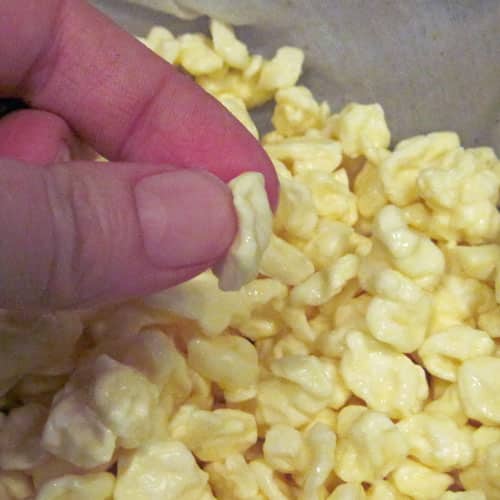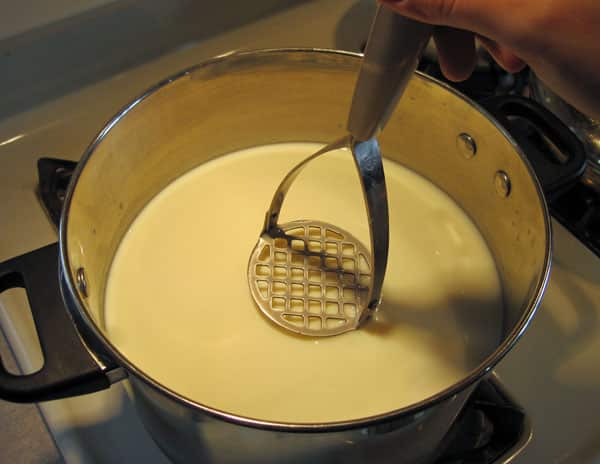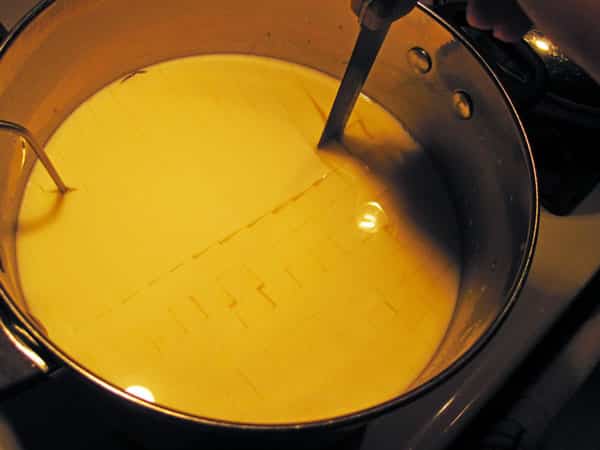How Do I Make My Cotage Cheese Large Curd
This post may contain affiliate links which won't change your price but will share some commission.
If you've tried the 30 minute mozzarella cheese and the fromage blanc cheese (or even if you haven't) and would like to tackle a slightly more challenging cheese recipe, then you may be ready to to learn how to make cottage cheese. Homemade cottage cheese can be ready for eating fresh or using in recipes in just a matter of hours (and you may just impress your friends and family with you tasty cheese craftiness).

This recipe is adapted from the large curd cottage cheese in the book Home Cheesemaking by Ricki Carroll. I can't recommend this book enough.
*Note: This cheese needs to sit for several hours to culture, so make sure you plan ahead so you have enough time.
Contents
- Homemade Cottage Cheese Recipe
- Homemade Cottage Cheese
- Ingredients
- Instructions
- Did you make this recipe?
Homemade Cottage Cheese Recipe
Ingredients
- 1 gallon pasteurized milk, skim or whole
- 1/8 teaspoon calcium chloride diluted in 1/4 cup water (if using store bought milk)*
- 1 package direct-set mesophilic starter, 1/4 teaspoon bulk mesophilic starter or 4 ounces prepared mesophilic starter
- 1/4 teaspoon liquid rennet (or 1/4 rennet tablet) dissolved in 1/4 cup cool water
- cheese salt (optional)
- cream, 1-2 tablespoons (optional)
- herbs (optional)

1. Warm the milk to 72F. If using calcium chloride*, add it now. Add the starter and mix thoroughly. I will normally use skimmed milk for this cheese and save the cream for another recipe, adding a little cream back in at the end for a richer flavor. I make this cheese in a large, stainless steel pot with a very thick bottom. If you have a large double boiler or want to rig up a double boiler by nesting two pots, that might also be helpful.
2. Add 1 tablespoon of the diluted rennet and mix thoroughly with a gentle up and down motion. I use my potato masher to blend the rennet up and down through the milk. Cover and let set at 72F for 4-8 hours, or until the curd coagulates. The curd will be rather soft.

3. Cut the curd into 1/2 inch cubes. Allow to set, undisturbed, for 10 minutes. use a long knife that reaches all the way to the bottom of your pan, and move smoothly and gently – don't tear the curd. Try to keep your cubes as uniform as possible so your cheese cooks evenly.

Cut the curd into 1/2 inch cubes
4. Place the pot on low heat. Increase the heat by two degrees every 5 minutes, until the temperature reaches 80F. Stir gently to prevent the curds from matting. On my stove, I use my smallest burner set to 1 or 2, and set my kitchen timer for five minutes, and then watch, stir, and adjust the heat accordingly. If you have a large double boiler, you may prefer to use that instead for more even, gentle heat.
5. Increase the heat by three degrees every 5 minutes, until the temperature reaches 90F, stirring gently to prevent the curds from matting.
6. Increase the heat by one degree per minute, until the temperature reaches 110F, stirring gently to keep the curds from matting. Again, watch your heat and try not to heat too fast. Slow, gentle cooking makes for a more tender curd.
7. Maintain the temperature at 110F for 20 minutes, or until the curds are sufficiently cooked and no longer have a custard-like interior. Stir gently every few minutes.

8. When the curds are sufficiently cooked, let them settle to the bottom of the pot for 5 minutes.
9. Pour off the whey. Pour the curds into a colander lined with cheesecloth. Tie the corners of the cheesecloth into a knot. If a less sour cottage cheese is desired, wash the curds by dipping the bag several times into a bowl of cool water.

10. Let the bag drain for several minutes.
11. Rinse the bag in a bowl of ice water to cool and place the bag in a colander to drain for 5 minutes.
12. Untie the bag and place the curds in a bowl. Break up any pieces that have matted. If desired, add the heavy cream to produce a creamier texture. (I always add the cream, but the cream free cheese will be lower in lactose.) As you can see from the photos, this makes a LARGE curd cottage cheese, which we prefer. The Home Cheesemaking book also includes the recipe for small curd cottage cheese.

13. Add the salt and herbs to taste, if desired.
14. Store in a covered container in the refrigerator for up to one week.
Yield: 1 1/2 pounds
This cheese takes about 6-10 hours from start to finish, with 4-8 hour rest time. When the curds were super fresh (right out of the pot) they squeaked, but by the next day the squeak was gone. I usually make this when I have other flexible tasks to do in the kitchen so I can check on it as needed. It doesn't require constant attention.
*Note – Calcium chloride is added to milk that has been commercially pasteurized because the heating process decreases the amount of calcium in the milk, which negatively affects the coagulation of the milk (so the rennet can't do its job as well). To pasteurize milk at home, heat the milk in a clean non-reactive pot to 145F and hold for 30 minutes, then chill in an ice bath to 40 F and refrigerate until ready to use. I have never bothered to pasteurize the milk for this recipe and it has worked just fine for me. I assume no liability for your choice of milk use. I figure we should all have the right to choose the food we eat.
For those who are a little more daring, you may be able to use nettle rennet in this cheese with good results, but I have not tried it yet.
I purchase some of my cheesemaking supplies locally from House of Homebrew. The rest I order through Cultures for Health.
I hope you'll give this recipe a try. It's a good way to use up skimmed milk (I prefer full fat for most recipes and drinking). Let me know what you think, and if there are other recipes you'd really like to see.
Printable Recipe
Homemade Cottage Cheese
- 1 gallon pasteurized milk, skim or whole
- 1/8 teaspoon calcium chloride diluted in 1/4 cup water (if using store bought milk)*
- 1 package direct-set mesophilic starter, 1/4 teaspoon bulk mesophilic starter or 4 ounces prepared mesophilic starter
- 1/4 teaspoon liquid rennet (or 1/4 rennet tablet) dissolved in 1/4 cup cool water
- cheese salt (optional)
- cream, 1-2 tablespoons (optional)
- herbs (optional)
1. Warm the milk to 72F. If using calcium chloride*, add it now. Add the starter and mix thoroughly. I will normally use skimmed milk for this cheese and save the cream for another recipe, adding a little cream back in at the end for a richer flavor. I make this cheese in a large, stainless steel pot with a very thick bottom. If you have a large double boiler or want to rig up a double boiler by nesting two pots, that might also be helpful.
2. Add 1 tablespoon of the diluted rennet and mix thoroughly with a gentle up and down motion. I use my potato masher to blend the rennet up and down through the milk. Cover and let set at 72F for 4-8 hours, or until the curd coagulates. The curd will be rather soft.
3. Cut the curd into 1/2 inch cubes. Allow to set, undisturbed, for 10 minutes. use a long knife that reaches all the way to the bottom of your pan, and move smoothly and gently – don't tear the curd. Try to keep your cubes as uniform as possible so your cheese cooks evenly.
4. Place the pot on low heat. Increase the heat by two degrees every 5 minutes, until the temperature reaches 80F. Stir gently to prevent the curds from matting. On my stove, I use my smallest burner set to 1 or 2, and set my kitchen timer for five minutes, and then watch, stir, and adjust the heat accordingly. If you have a large double boiler, you may prefer to use that instead for more even, gentle heat.
5. Increase the heat by three degrees every 5 minutes, until the temperature reaches 90F, stirring gently to prevent the curds from matting.
6. Increase the heat by one degree per minute, until the temperature reaches 110F, stirring gently to keep the curds from matting. Again, watch your heat and try not to heat too fast. Slow, gentle cooking makes for a more tender curd.
7. Maintain the temperature at 110F for 20 minutes, or until the curds are sufficiently cooked and no longer have a custardlike interior. Stir gently every few minutes.
8. When the curds are sufficiently cooked, let them settle to the bottom of the pot for 5 minutes.
9. Pour off the whey. Pour the curds into a colander lined with cheesecloth. Tie the corners of the cheesecloth into a knot. If a less sour cottage cheese is desired, wash the curds by dipping the bag several times into a bowl of cool water.
10. Let the bag drain for several minutes.
11. Rinse the bag in a bowl of ice water to cool and place the bag in a colander to drain for 5 minutes.
12. Untie the bag and place the curds in a bowl. Break up any pieces that have matted. If desired, add the heavy cream to produce a creamier texture. (I always add the cream, but the cream free cheese will be lower in lactose.) As you can see from the photos, this makes a LARGE curd cottage cheese, which we prefer. The Home Cheesemaking book also includes the recipe for small curd cottage cheese.
13. Add the salt and herbs to taste, if desired.
14. Store in a covered container in the refrigerator for up to one week.
How Do I Make My Cotage Cheese Large Curd
Source: https://commonsensehome.com/how-to-make-large-curd-cottage-cheese/